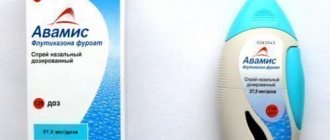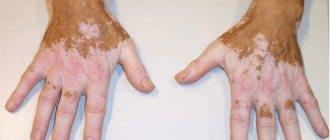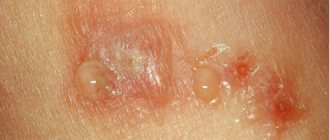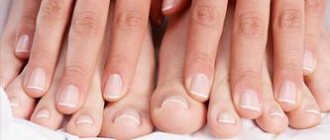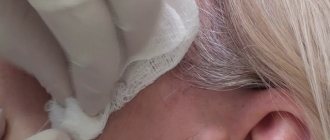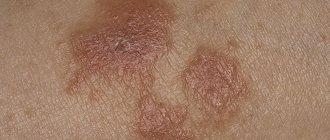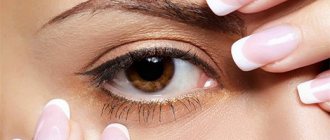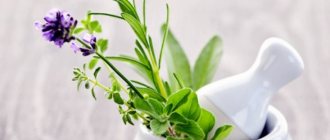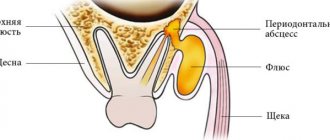- August 18, 2018
- Dermatology
- Alina Naumova
In this article we will look at the symptoms and treatment of venous dermatitis in adults on the legs and photos of the pathology.
The disease is also called varicose eczema of the lower extremities. The disease is considered a dermatological disease that occurs in a chronic form. Venous dermatitis occurs as a result of circulatory disorders in the veins, due to the formation of blood clots in deep vessels.
Causes of pathology
Venous dermatitis of a non-inflammatory type, which occurs in a chronic form, is a complication if a person has varicose veins. Thus, the factors that influence the appearance of venous dermatitis are the following prerequisites:
- The presence of stagnation of blood in the vessels.
- Failure of the heart valves.
- The presence of excessive pressure in the veins.
- Presence of dilated vessels.
Treatment of venous dermatitis on the legs (photos of the disease are presented in the article) should be comprehensive.
Risk factors
The following risk factors are identified that can lead to the development of pathology:
- The presence of blood clots in the veins.
- Injuries of the lower extremities.
- Overweight and old age.
- The presence of pathologies of the endocrine system.
- The presence of vascular pathologies of various etiologies.
In addition, pathogens of infectious pathologies can also affect the condition of the veins. This is due to the production of toxins by pathogenic organisms that can cause eczema.
Treatment of venous dermatitis is carried out by a phlebologist.
Preventive measures
Measures to prevent venous dermatitis are as follows::
- proper nutrition;
- physical activity;
- choosing comfortable clothes and shoes;
- use of contrasting water procedures and massage.
If a person is forced to constantly sit or stand, fluid accumulates in the lower extremities and circulatory problems occur. Therefore, it is useful periodically:
- hike;
- take long walks in the fresh air;
- to live an active lifestyle.
Varicose dermatitis is a rather dangerous pathological condition that requires proper and timely treatment. If you start therapy at an early stage of the disease and subsequently adhere to preventive measures, the prognosis will be favorable. An advanced disease is fraught with dangerous consequences , including disability.
Signs of pathology
The progression of this disease can occur over a long period of time. In its development, this disease goes through several stages at once. Moreover, some manifestations accompany pathological processes on an ongoing basis, while other symptoms are characteristic only of certain stages of development. This sometimes makes diagnosis difficult and requires a non-standard approach to the treatment of venous dermatitis at each stage. So, this disease manifests itself as follows:
- The appearance of pain and fatigue in the legs, which may become most pronounced in the evening.
- The occurrence of swelling of the tissues of the lower extremities.
- In the area of the affected veins, the skin turns red and becomes bluish.
- Pigmentation of the superficial skin layer may be observed.
- Presence of skin irritation with itching.
- The appearance of an open wound along with peeling of the dermis.
- The appearance of ulcers in the affected areas of the skin.
- The appearance of a rash in the form of blisters.
- Gradual detachment of fatty tissue, roughening of the skin in the area of scar formation.
Diagnosis of the pathology is carried out at the first signs of venous dermatitis, as this makes it possible to avoid the transformation of the disease into a chronic form. When conducting diagnostics, it is very important to follow an integrated approach.
Stages
Varicose dermatitis has a long-term chronic course, although rapid progression is not excluded. Before the appearance of trophic ulcers, the disease goes through several stages:
- At an early stage, by the end of the day, slight swelling and heaviness in the legs regularly appear.
- Veins begin to protrude on the lower extremities, a red-violet vascular network appears under the skin in the shin area, and pain intensifies in different parts of the legs.
- Swelling of the subcutaneous tissue increases and does not go away well, which is associated with impaired lymph outflow. The skin becomes bluish, denser, dry, itching appears, and pain intensifies.
- Sensitivity in the lower extremities is impaired, and convulsions occur. Areas with pronounced pigmentation, flaky brownish spots, and blisters filled with light liquid appear on the legs, which open and form a weeping surface. In place of the opened and dried blisters, gray-yellow or hemorrhagic crusts appear, after which areas of hyperpigmentation remain.
- At the last stage, single or multiple venous ulcers are formed, which, if left untreated, increase in size and can fester if infected.
Diagnostics
Vein dermatitis cannot be diagnosed by visual examination of the affected limb. This can be explained by the fact that the symptoms of the pathology are individual in nature and may differ for each patient. There are currently no specific methods for diagnosing venous dermatitis.
In order to perform differential diagnosis, the patient is examined, anamnesis is collected and a comparative analysis is performed. In some cases, an additional examination is also prescribed, which involves an ultrasound examination and blood donation.
Making a diagnosis for varicose veins
IMPORTANT! To make a diagnosis and prescribe the appropriate course of treatment, you must contact a qualified specialist.
Each patient has his own unique symptoms and manifestations of the disease. The doctor performs a physical examination, and sometimes additional laboratory tests may be needed to confirm the presence of the disease.
A test for allergic reactions is also carried out. If the test gives a positive result, allergens are identified and a list of measures necessary to get rid of allergens in everyday life is compiled.
Treatment of venous dermatitis
The therapeutic regimen for the presence of this disease involves treatment in two directions at once. To begin with, symptomatic therapy of venous dermatitis is carried out, during which itching is eliminated along with peeling, swelling and ulcers. Next, it is necessary to eliminate the causes that caused the pathology, that is, treat varicose veins, improve blood circulation in the vessels and restore metabolic processes. What else may be effective in treating venous dermatitis? Answering this question, it is worth mentioning folk methods.
How to treat varicose dermatitis
To cure varicose dermatitis, you need to devote a sufficient amount of time and effort to each of the listed factors:
- Improve venous outflow from the legs.
- Remove swelling.
- Eliminate inflammation.
- Moisturize the affected skin to prevent it from cracking.
- Prevent suppuration.
To achieve these goals, both systemic therapy (tablets, injections) and ointment treatment are used. Therapy is specific for each stage of varicose dermatitis.
Treatment of stage 1 of the process
To improve venous outflow, diosmin-based products are used: Detralex, Venorus, Phlebodia. This active substance, produced in the form of capsules, helps to increase the tone of the muscle cells of the venous vessels.
To eliminate venous stagnation, you need compression garments. These are stockings or tights, the task of which is to do the work of the weakened wall of some veins. They should be selected by a phlebologist or angiosurgeon based on Dopplerography of the vessels of the extremities. As a result of wearing compression clothing, not only the manifestations of varicose dermatitis can go away, but the degree of varicose disease itself can decrease. Such underwear reduces the risk of blood clots and reduces swelling of the legs; the latter begin to get tired much less.
How to relieve itching with varicose dermatitis at this stage? Antihistamines are used here in the form of systemic agents (Cetrin, Erius, Zodak, Diazolin) and ointments (Fenistil, Psilo-Balm).
Itching gels
To prevent the thickening skin from venous dermatitis from cracking, it is necessary to use moisturizing creams or lotions: Seni Care gel, Seni Care cream with arginine, baby cream with neutral pH and some others. If there are blisters on the legs, they need to be treated with a zinc or talc powder prescribed by a dermatologist (they are prepared in pharmacies with prescription departments), or Skin-Cap gel. Additionally, areas with venous dermatitis should be treated with protective creams “Seni Care” or “Menalind professional” containing zinc.
The use of venotonics and antihistamines for varicose dermatitis helps eliminate inflammation, swelling and itching, and prevent infectious complications that can arise from scratching. Therefore, these drugs at the first stage are sufficient for treatment. In addition to the main treatment plan for venous dermatitis, folk remedies can be used.
Therapy at stage 2
How to treat varicose dermatitis at this stage? It also includes taking venotonic drugs and wearing compression garments, as in the previous stage. Only the treatment of itching of the extremities changes. For this purpose, not only systemic antihistamines are used, but also hormonal ointments applied to areas of inflammation. These are Elokom, Lokoid, Sinaflan creams, used in short courses.
If there is suppuration, combination ointments containing an antiseptic (or antibacterial) agent together with a hormonal agent are used to treat varicose dermatitis. These are Triderm, Pimafukort and others.
In addition, it is important to take light sedatives (valerian, motherwort, Sedasen) or “daytime” tranquilizers (Adaptol).
Treatment at stage 3
If, as a result of the development of venous dermatitis, a trophic ulcer has formed, the only thing that can help is an operation aimed at removing the pathologically altered veins. But it cannot be carried out in the presence of a recently emerging or festering ulcer - acute inflammation must be eliminated. For this, preparatory therapy is carried out:
- Bed rest is prescribed with the limb elevated by 20-30° to ensure blood and lymph drainage.
- Wash the ulcer and remove particles of dead tissue.
- Medicines are administered intravenously or intramuscularly to improve the patency of blood vessels in the extremities.
- The legs are compressed using elastic bandages.
- Monitor blood glucose and reduce it (if necessary).
- Antihistamines are used in the form of injections.
General principles of care
If you have venous dermatitis, you need to pay attention to foot care. They should be washed daily with water in which soap has been dissolved (for example, TENA Wash Mousse or TENA Wash Cream). Next, they are wiped with blotting movements and treated with moisturizing creams or hormonal ointments, depending on the stage of the disease.
TENA soap products
The diet must include foods rich in rutin, a vitamin that improves the tone of venous vessels. These are bell peppers, rowan berries grated with sugar, and buckwheat porridge.
It is important to monitor your body weight, preventing it from increasing, that is, increasing the load on legs with varicose or thrombosed veins. It is necessary to be examined by an endocrinologist to rule out diabetes mellitus and those pathologies that can lead to obesity (diseases of the adrenal glands, thyroid gland, pituitary gland).
Varicose dermatitis is a chronic pathology, which, until the venous problem is completely eliminated, will “maintain” the inflamed state of the skin. Therefore, another task for the patient is to prevent trauma to the affected skin. To do this, you need to wear clothes that will not injure your legs: made from natural materials that do not cause compression of the limbs. For women, dresses and skirts are optimal.
In addition, a person with varicose dermatitis must pay special attention to the comfort of their shoes. It should not squeeze the legs, consist of natural materials, and avoid the “greenhouse effect” of the feet.
Treatment with folk remedies
In addition to the main treatment of varicose dermatitis, traditional medicine is used:
- Potato compress. Made from fresh grated potato tuber. It is believed that it helps even at stage 3 of varicose dermatitis, ensuring good healing of trophic ulcers. To do this, place the resulting pulp on sterile gauze, and place it on the ulcer, and cover the top with another sterile gauze. Keep the compress for 4 hours, twice a day. Course – 2 weeks.
- Compress with cabbage leaf. Take a cabbage leaf, beat it lightly (until soft), wrap it around the leg affected by varicose dermatitis and wear it for up to two days, after which you replace it with a new one.
- Rubbing with infusion of birch buds. Take a 0.5 liter bottle, fill it ¾ full with birch buds, fill it with vodka up to the neck. Leave the buds for a week, then lubricate your feet 2-3 times a day with the resulting liquid.
- Compress made from infusion of wormwood leaves. Take 1 tbsp. l. wormwood leaves, grind them in a mortar, mix with 3 tbsp. l. curdled milk. Place the mixture on sterile gauze and apply it to the affected skin. The compress lasts for 15-20 minutes. Course – 2-3 weeks.
Traditional methods
Diseases such as varicose veins and the venous dermatitis accompanying this pathology have long been known to medicine. Treatment of venous dermatitis through the use of traditional methods has been changed and expanded for a long time. Today it will be possible to find quite a lot of different ways to treat this disease at home. As a rule, all kinds of plants are used in therapy, for example, chamomile, wormwood, hops, aloe and so on.
Plants are used in the treatment of venous varicose dermatitis as follows:
- Aloe juice is excellent for preparing infusions and ointments. The plant can have anti-inflammatory, antibacterial and moisturizing effects.
- Chamomile is used to make infusions and decoctions that dry and disinfect the skin. In particular, this medicine is often recommended to eliminate weeping eczema.
- A paste is prepared from a spice known as turmeric, which relieves swelling and irritation, as well as allergies and itching.
- Tea tree oil has excellent soothing and antiseptic properties. However, it is not used in its pure form; it must be diluted in a small amount of water.
- Ulcers that appear on the skin can be treated by applying a paste previously prepared from raw potatoes.
- Wormwood infusion also helps with varicose veins.
- A decoction is made from hop cones, which is used internally or externally.
Treatment of venous dermatitis with folk remedies can be very effective.
Experts warn that medications should not be neglected during therapy. Traditional recipes serve only as supportive therapy, but are not at all a panacea for this disease.
Clinical picture
- Itching - dry skin flakes, itching worsens mainly at night. The skin turns red and slight swelling may be noticeable. Over time, this part of the skin begins to secrete fluid and turn brown.
- Skin ulcers - during this period the patient notices a lack of appetite, general weakness and irritable behavior.
- Development of trophic ulcers - skin pigmentation first appears, after which the spots transform into ulcers.
In addition, based on the clinical picture, specialists can determine the stage of development of varicose dermatitis. For example, the first stage is characterized by small petechiae, as well as fusion of dermatitis areas, peeling of the skin, and itching. The second stage is manifested by increased pigmentation due to the transformation of hemoglobin. Under the ankles, the skin becomes atrophic.
Conservative treatment
The main goal of treating venous dermatitis is to improve the health of the veins and overall blood flow. In addition, they treat the symptoms of dermatitis - relieve itching along with irritation, swelling, eliminate ulcers, peeling and inflammation, and so on. Both oral preparations and local emulsions with ointments can be used to treat venous dermatitis. The group of recent drugs includes antihistamines along with anti-inflammatory, diuretic and antibacterial drugs, as well as glucocorticosteroids and so on.
To treat the affected areas of the skin, ointments are used for the treatment of venous dermatitis on the legs (photo presented) based on zinc, menthol, and the like. As part of complex treatment, sedatives are prescribed, for example, valerian, hawthorn, motherwort, and so on. In the event that the disease is in an advanced state, then antibacterial drugs with a wide range of effects are prescribed. For severe pain, various tranquilizers are indicated. As part of home treatment methods for this disease, it is advisable to wear compression garments.
Schemes for choosing medications
Only a doctor can determine a specific treatment regimen and choice of medications, based on the degree of advanced disease:
- Initial stage - venotonics and moisturizers are prescribed. If there is a feeling of severe itching, take antihistamines. Irritation calms down, and swelling gradually disappears.
- During the acute period of the disease, sedatives and hormonal ointments are added to the antihistamine medications used. In this way you can relieve itching and inflammation of the skin of the lower extremities.
- Chronic course of the disease - it is necessary to recover from the underlying disease (varicose veins of the legs). It is recommended to care for the skin of the legs (moisturize) and monitor to prevent relapse.
Compression underwear
In the remission stage of this disease, patients are advised to wear compression garments. Against the background of compression of the veins, normalization of vascular pressure is achieved, and at the same time blood flow improves. Blood flow under the influence of compression is usually redistributed to healthy vessels, which contributes to the effective restoration of fluid outflow and favors metabolic processes.
You can select compression garments and wear them only on the recommendation of a doctor, since such a preventive method has a number of contraindications. Such underwear should not be used for atherosclerotic changes, arterial pathology, or for patients with hypersensitive skin.
Gymnastics as a method of treatment at home
Therapeutic exercises make it possible to maintain and, in addition, control the condition of the veins. This method perfectly complements the treatment of varicose eczema. The main recommendation is to avoid excessive stress on the affected legs. The exercises are simple and involve lifting on your toes in various positions, namely:
- Sitting on a chair.
- With support on your hands, you need to stand on your feet.
- With arms down in a standing position.
- The arms are raised up in a standing position.
- The arms are extended forward in a standing position.
Regular walking will bring no less benefit in the process of home therapy. At the same time, shoes must be comfortable, they should not restrict movement, and it is prohibited for them to squeeze the legs. During the period of remission, such patients are allowed to visit the pool, and, in addition, fitness.
Prevention
Since the main cause of the disease is blood stagnation in the extremities, preventive measures are based on sufficient physical activity of the patient. Playing sports, walking in the fresh air, and cycling are not only a great pastime, but also a guarantee of the absence of problems with blood circulation throughout the body. Contrast water procedures and therapeutic massage help strengthen veins (at least twice a year).
Patients predisposed to the formation of varicose veins need to wear comfortable shoes and clothing, and also control their body weight. We should not forget about proper nutrition, which helps the body stay in good shape and prevents the development of pathological conditions.
Physiotherapy
The physiotherapy office is ready to offer such patients several procedures at once that will help eliminate venous dermatitis. The appointment should be made by a physiotherapist or phlebologist, taking into account the stage of development of the disease and the nature of the manifestation of the pathology. The most popular procedures are:
- Carrying out electrophoresis and pulsed magnetic therapy using eddy currents.
- Carrying out darsonvalization and intermittent pneumocompression.
- Performing balneotherapy, magnetic and laser simultaneous effects.
- The use of hydrotherapy, oxygen baths and ultraviolet irradiation.
- Conducting ozone therapy and phototherapy.
Use of medicinal ointments
Ointments with an anti-inflammatory effect that are used in the treatment of venous dermatitis include Diclofenac and Voltaren. In addition, ointments containing hormones can be used. If varicose dermatitis is acute, hormonal treatment may be prescribed. The most effective ointments are considered to be products such as Flucinara, Lorinden and Advantana.
Ointments for the treatment of venous dermatitis on the legs of a wound healing nature include “Solcoseryl” and “Bipanten”. If there are ulcers, the patient may be prescribed Argosulfan or Dermazin ointment. Hormonal ointments with the most effective effect of use include the following medications:
- The drug "Prednisolone" is an analogue of cortisone. Its main task is to relieve itching and redness. Due to the hormone content, the use of this medicine is possible for no longer than fourteen calendar days. After completing the treatment course, you should stop using the ointment for three weeks. A repeat appointment is then possible. Adverse reactions include cycle disruption in women along with weight gain.
- Soderm ointment for the treatment of venous dermatitis contains corticosteroids. The main effect of use is to relieve itching and pain in the legs. The use of this product is allowed no more than three times a week. Parallel use with other drugs is strictly prohibited. Adverse reactions in this case are allergies and disorders of the kidneys.
- Advantan ointment must be squeezed onto the affected area of the skin and rubbed thoroughly. This ointment should be used no more than four times a week. This remedy has a healing property, and the affected skin is very quickly replaced by a healthy area when using this medicine.
Thus, there are currently quite a lot of ways to treat pathology. It is worth noting that any home methods should not be used separately, but as part of a comprehensive treatment.
We looked at the symptoms and treatment of venous dermatitis in adults on the legs. Photos of people with this disease were presented.
Symptoms
Varicose dermatitis received a second “folk” name – “venous eczema”. The essence of the disease lies in negative metamorphoses occurring in the valve apparatus of the vein and the walls of blood vessels.
The signs and symptoms of varicose dermatitis may vary from patient to patient. The main symptoms characteristic of this disease:
- The skin on the lower legs becomes red with a purple tint;
- The skin is hot and inflamed;
- The occurrence of persistent itching;
- Edema formation;
- Formation of blisters on the skin, which can burst and crusts form in their place;
- The appearance of “wet” areas of skin on the legs;
- Brown spots may be found on the skin, rough and rough to the touch;
- If the disease is neglected, ulcers are possible.
The main habitat of “varicose eczema” is the ankles and lower legs. Severe itching, tormenting the patient day and night, provokes him to scratch the affected area of the leg.
There is a risk of the formation of “open wounds” and infection. This condition makes the patient irritated, excites his nervous system and does not allow him to sleep peacefully. Varicose dermatitis of the lower extremities in the photo demonstrates how symptoms can manifest.
The use of cosmetic preparations with different contents of substances can have a negative effect on already developing dermatitis. It is important to consult a doctor in a timely manner and get competent advice.
